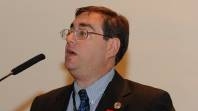AES convention looks to CALM loudness concerns

With the government threatening to begin fining broadcasters that do not comply with new audio loudness levels, audio professionals can get the latest information on how to handle audio feeds coming at the upcoming Audio Engineering Society (AES) Convention in New York City, October 19-22. The annual gathering of audio professionals and related equipment vendors is expected to attract between 16,000 and 18,000 attendees this year.
David Bialik, chairman of the Broadcast & Streaming Sessions, said the CALM Act has a lot of people confused and concerned about how to comply in the most cost-effective way. As he said, broadcasters do not gain any more revenue by adhering to the mandate.
“Broadcasters are not the end game anymore, because they are providing content to the various cable, satellite and telco services that are, in turn, adjusting audio levels as they see fit,” Bialik said. “Since Congress can’t seem to resolve the nation’s debt problem, or the various wars we are fighting, they decided to fight loudness. So broadcasters are left to jump through a few hoops or face fines of up to $10,000 for a first-time offense.”
[Editor’s Note: The FCC is supposedly going to hold the organization that last touches a specific program accountable, not the program originator. So, a producer would not be liable for the audio levels of their show once it’s distributed by a cable TV or satellite service.]
Bialik, who has helped developed the broadcast and streaming sessions since 1986, said this year’s “Broadcast Streaming” sessions provide a good mix of topics to address all of the different disciplines involved with producing TV programs and delivering them to viewers for the most enjoyable at-home experience.
“The industry is moving rapidly from a pure terrestrial broadcast model to include all types of audio and video streaming to the ever growing number of distribution platforms that have to be supported in order to stations to stay competitive,” he said. “Today’s broadcasters are managing a different type of bandwidth (IP) in addition to their traditional baseband infrastructure.”
In addition to an array of highly technical sessions to help engineers process and manage the ever-increasing number of audio sources, there are creative sessions such as “Listener Fatigue and Retention,” which will discuss how producers can create programs that keep viewers in their seats. This panel is moderated by David Wilson, CEA, and includes participations from panelists Ellyn Sheffield, Towson U. (MD); Sean Olive, Greg Monti, Citadel Media; Frank Foti, Omnia; Greg Ogonowski, Orban; Thomas Lund, TC Electronics; and Todd Baker, SRS Labs.
The professional video industry's #1 source for news, trends and product and tech information. Sign up below.
“At the end of the day, if viewers are not happy with a program, they will tune it out,” Bialik said. “We’ve presented this session for the past five years, and the attendance continues to grow. There’s clearly a need for this type of discussion in the broadcast industry.”
There are also sessions entitled “Improving The Streaming Audience Experience,” “Streaming & Encoding” and “Working With Content Delivery Networks,” which are all useful to today’s audio engineer.
The “Television Loudness and metadata” session is sure to get a lot of attention, as will a discussion on “Lip Sync” issues (a perennial topic that continues to plague live broadcasts). The loudness panel will be moderated by Skip Pizzi of the NAB and include panelists Robert Seidel, CBS; Steve Lyman, Dolby; and Andrew Mason, from the BBC.
“The job of the broadcast audio engineer is becoming more and more complex as the years move on, so I think you're never finished learning new things and staying head of the curve,” Bialik said. “In developing the technical session and program tracks, we address the full lifecycle of a piece of content, from program inception to production, transmission and reception. An audio engineer has to understand all of the various stages in order to be successful.”
Of note: The AES convention will once again host a Society of Broadcast Engineers (SBE) Certification Exam session on Sunday, October 23 from 2 p.m. to 5 p.m., where engineers can sit through the course and walk away certified in a variety of disciplines. Engineers interested in registering for the exam may complete the Certification application at http://www.sbe.org/sections/cert_classif.php. Most levels of certification require some experience in broadcast engineering or a related field.
Applicants are encouraged to apply before the exams by going online and accessing the certification applications. You may apply on-site for the Certified Broadcast Technologist or the Certified Broadcast Networking Technologist exams. If you wish to apply for the broadcast engineer, senior engineer or specialist certifications, then you need to pre- register by Oct. 17. Further questions can be addressed to Megan Clappe, certification director at mclappe@sbe.org/.
